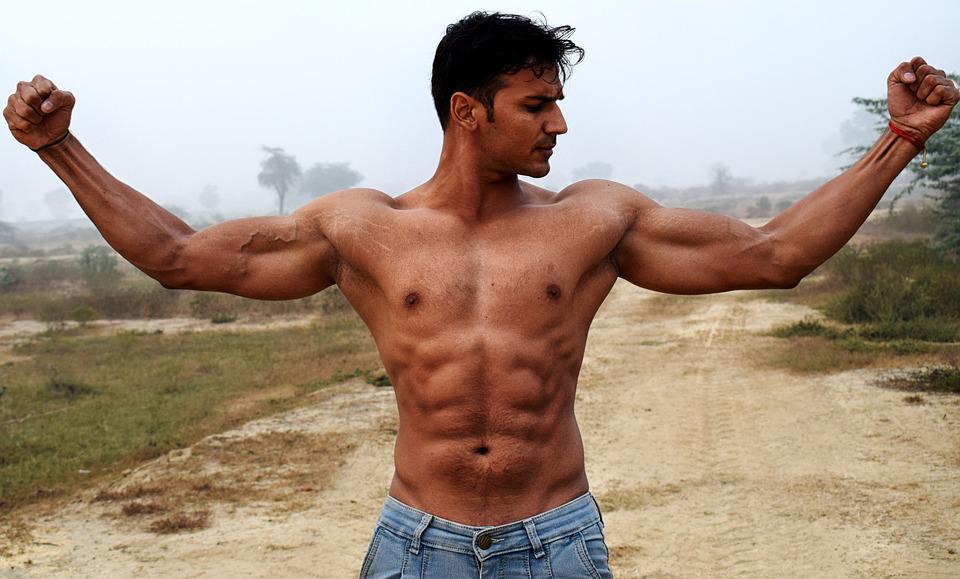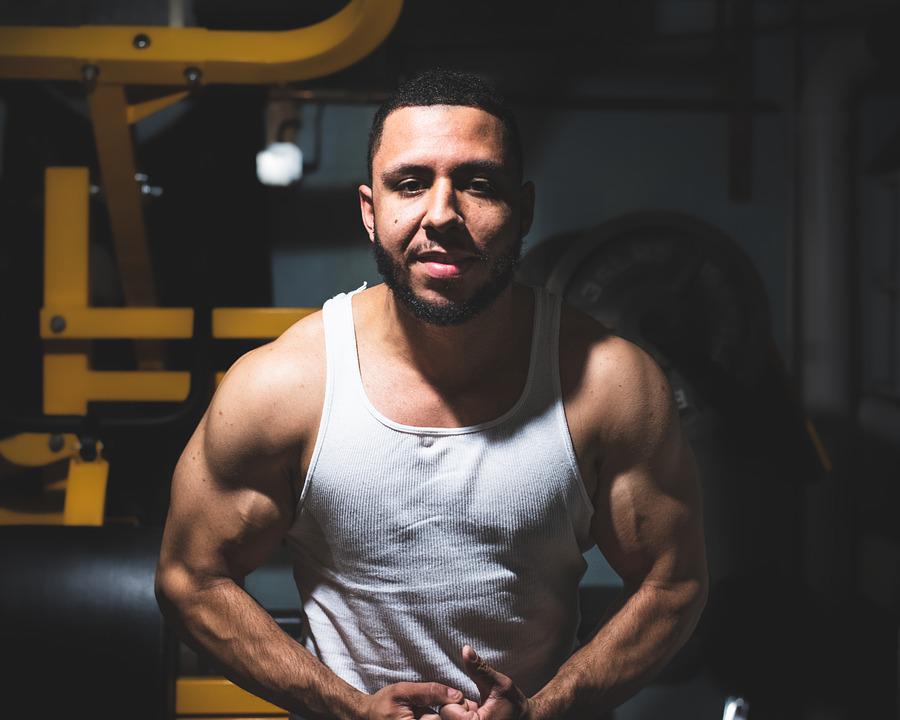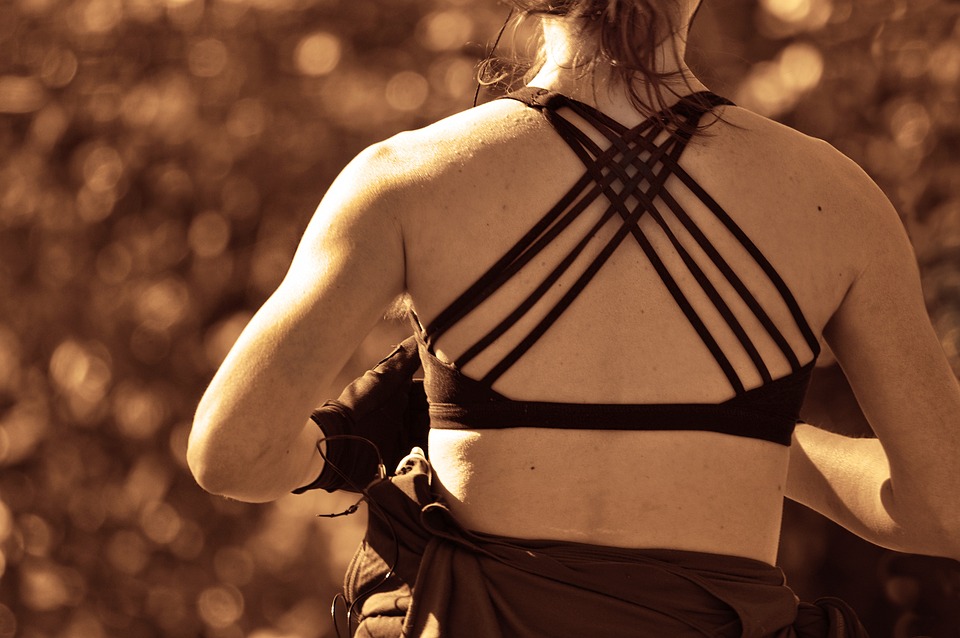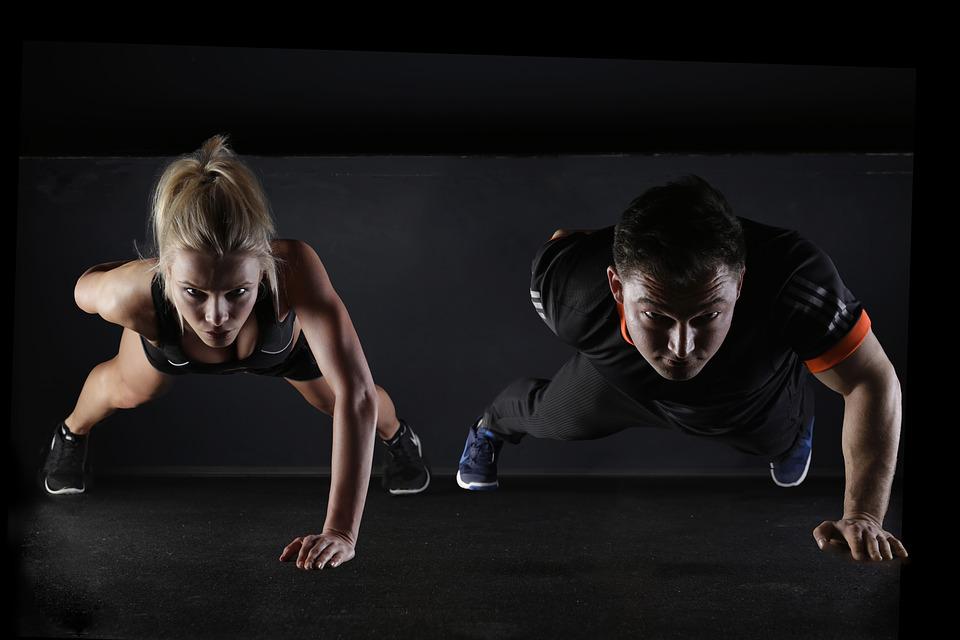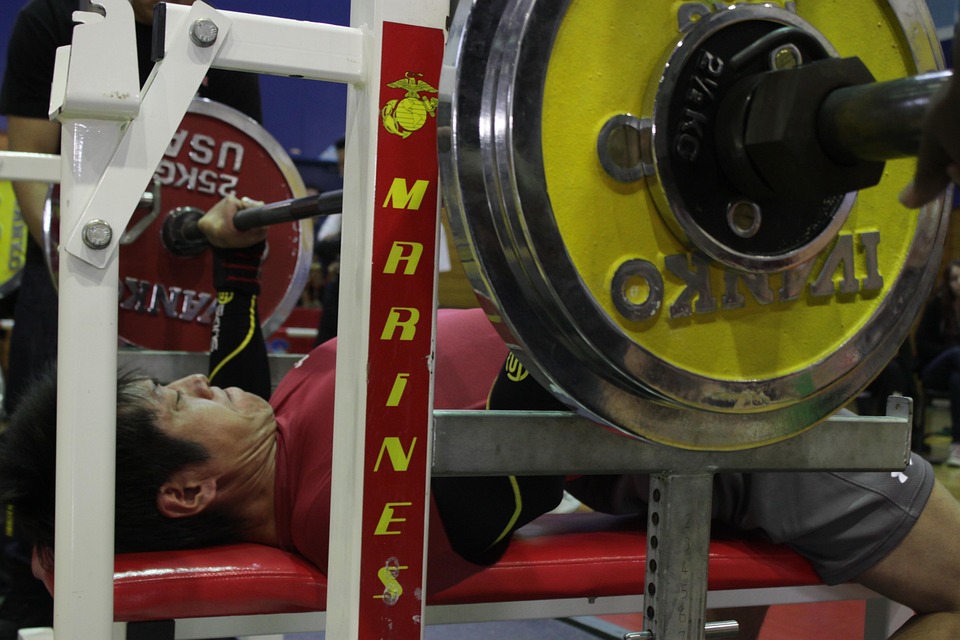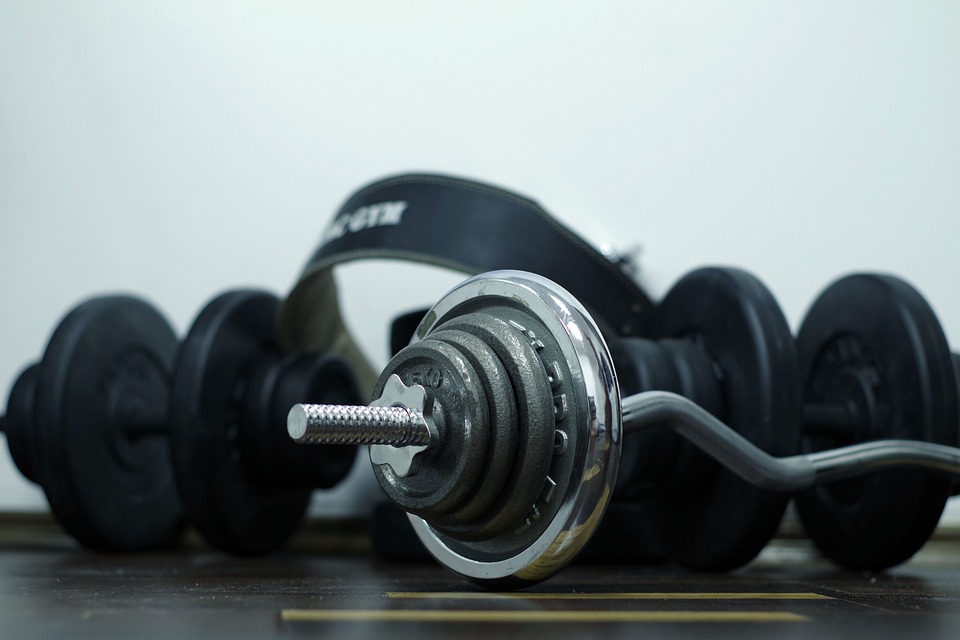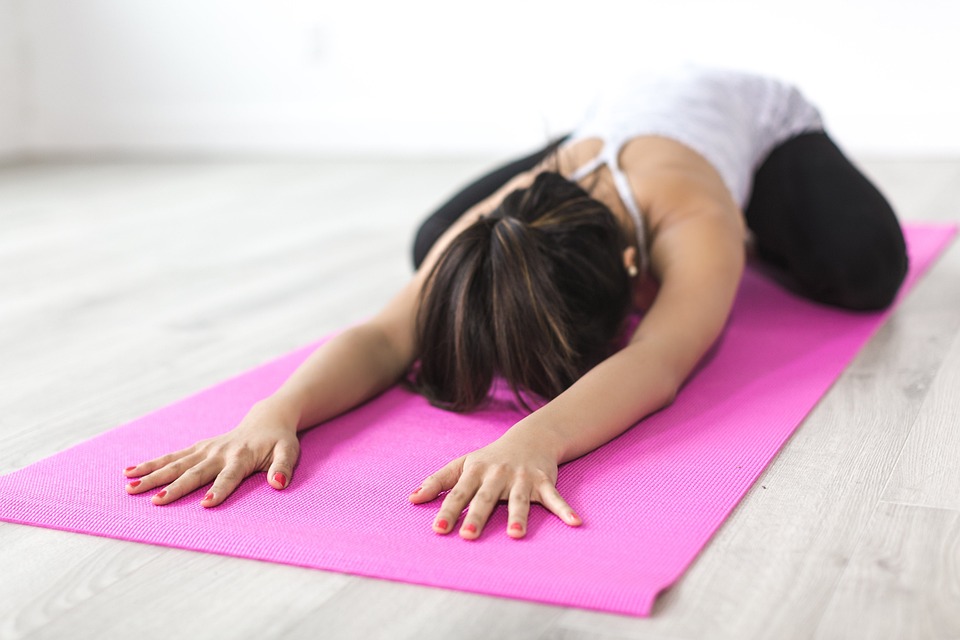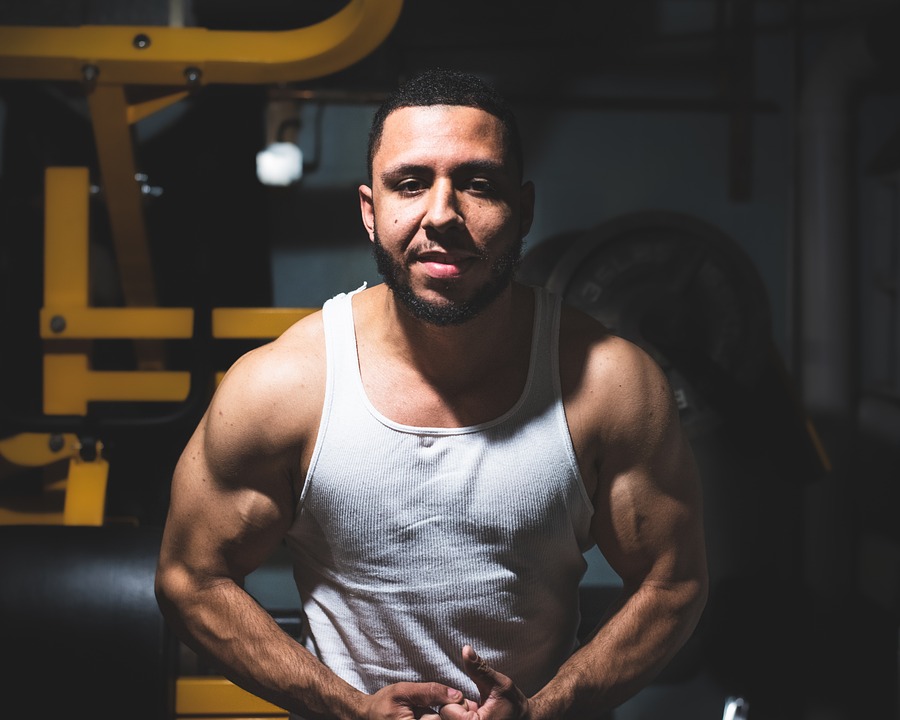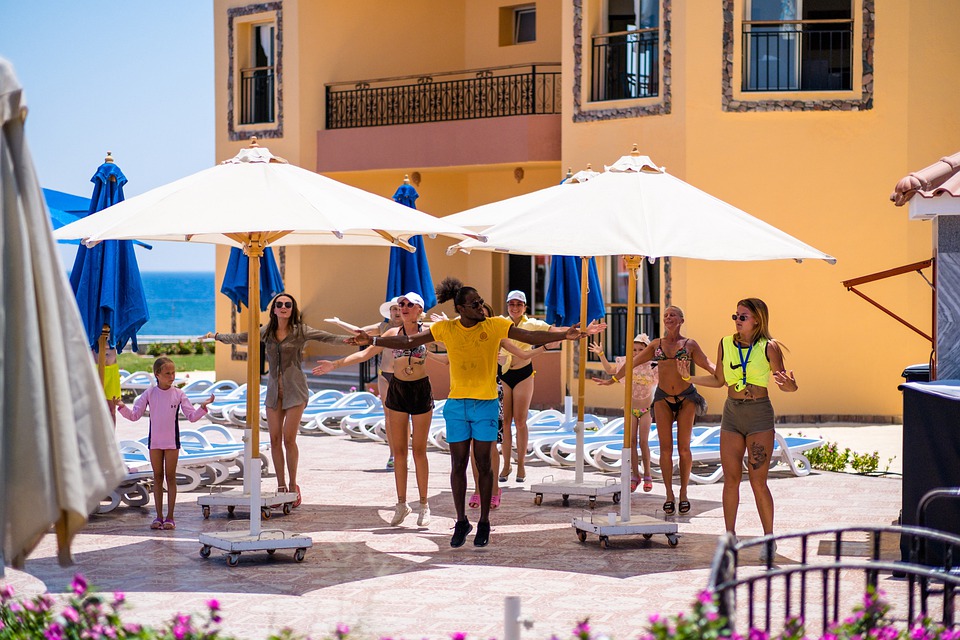
This article provides a few suggestions for exercising in a hotel room with minimal equipment. However, there are many other ways to exercise that are not included here.
Push
A push is a movement in which you use your upper body to push yourself or something else away. Your shoulder joint allows you to push in many different directions, so the options for push movements are mostly about changing the angles of your arms and hands to target different muscle groups. For example, holding your hands close together puts more stress on your triceps, whereas pushing closer to the ceiling targets your shoulders more (over your pectorals).
Push-up
Begin by getting down on all fours with your hands shoulder-width apart. Next, move your feet outward until your body forms a straight line from your neck to your toes. To help with this, squeeze your glutes together. Finally, lower yourself with your arms until your chest and thighs are just barely touching the floor. Then rapidly push yourself back into the starting position.
Push-up variations
The push up can be made more difficult by changing the placement of your hands, elevating your feet, or adding claps, arm raises, or crunches.
Chair dip
Start by placing your hands flat on a surface behind you, with your legs straight. Lower yourself down until your elbows are at a 90 degree angle, then push back up until your elbows are straight again. The more challenging this movement is, the higher your feet will be in relation to your hands.
Wall handstand
Get down on all fours, facing a wall, with your hands about six inches away from it. Carefully kick your legs up and over, until your heels hit the wall, putting yourself in a handstand position. Engage your shoulders and keep your spine straight as you hold this position.
Handstand push-up
Bend your elbows from a wall handstand until your head lightly touches the floor, then push back up to the full handstand position. Note that this is difficult, so don’t be discouraged if you can only do negative repetitions or partial repetitions at first.
Pull
There are two types of pulling movements- those where you use your upper body to pull yourself towards an object, and those where you use your upper body to pull an object towards yourself. Because one of these requires something to pull and the other requires a sturdy place to hold onto as you work against gravity, they can be difficult to do in a hotel room.
Doorway row
Stand in a doorway so that your chest and feet are touching one side. Grab onto the doorframe and lean back, keeping your arms straight, until you reach the other side of the doorway or your arms are straight. Use your back and biceps to pull yourself back up to the starting position. For more of a challenge, try doing this with one arm and the doorway to your side.
Table row
An inverted row, or horizontal row, is an exercise that is normally done with a racked barbell or purpose-built horizontal bar in a gym. However, it is possible to do this exercise with an improvised piece of equipment, such as the underside of a sturdy table or desk. To do this, grab the edge of the table from underneath, and straighten your body so that you are hanging underneath the table. Then, pull yourself up until your chest touches the underside of the table, and lower yourself back down in a controlled fashion.
Suitcase row
Although this isn’t technically a bodyweight movement, it’s still a great exercise to do with little to no equipment. To do a one-armed row with a suitcase, start by bending at the hips and knees until your hand is able to grasping the side handle of the suitcase. Once your hand is in place, begin to pull the suitcase up towards your chest until it touches, making sure to keep your hips, knees, and shoulders square. You can add or remove items from the suitcase to adjust the difficulty of the exercise.
Towel row
You will exercise by rowing while holding a towel or bed sheet that is pinned between a closed door and its door frame. Although it may seem scary, it is actually very stable as long as the towel or sheet does not slip around. This method also has the added benefit of allowing you to adjust the angle at which you are pulling.
Chin-up/Pull-up
To do this exercise, you will need either a pull-up bar or a sturdy door frame with a thick lintel. Start by grabbing the bar, then use your back and biceps to pull yourself towards the bar. Be sure to keep your upper back tight and your body in a straight line. Once you reach the bar, lower yourself back down in a controlled manner. If your palms are facing away from you, that’s a pull-up. If they’re facing towards you, that’s a chin-up.
Squat/Lunge
Both squats and lunges work the hips and knees to build strength in the thighs and glutes. Many “Functional Movement” experts see the squat and lunge as two different moves, but for most people, they’re just variations on the same theme.
Squat
Stand with your feet shoulder-width apart and your toes pointed straight forward or slightly outward. Bend at the hips and knees, keeping your knees out and your back relatively vertical, until your hips are below your knees. Push through the middle of your foot (not your heels or toes) as you stand back up.
Jump squat
This exercise is similar to a regular squat, except instead of standing up gently, you explode from the squat position into a jump.
Split squat
Stand with one foot placed on a chair, bed, or bench behind you with the toe pointing away from you. Next, bend the knee of your front foot until your back knee touches the ground, while keeping your chest up and your knee directly above your toes. Finally, use your glute and thigh muscles to push yourself back to the starting position.
Shrimp squat
This exercise is similar to a split squat, but instead of having a support for your back foot, you will just be holding it with your hand. You will then lower yourself until your back knee touches the ground. Be sure to keep your knee over your toes, and then push back up into a standing position. This exercise requires balance and strength, so if you need help, feel free to put your other hand on a wall or chair.
Pistol squat
The pistol squat is a squat where your non-active leg is extended straight in front of you, instead of behind you like in a shrimp squat. To do a pistol squat, extend your front leg, and then squat down to full depth and back up again on your rear leg. This exercise requires quite a bit of balance and strength, so you may want to use a door frame or a pole to support yourself as you learn how to do it.
Lunge
Stand with your feet shoulder-width apart. Step forward with one leg and bend your knees, lowering your back knee toward the floor. Push back up to the starting position. You can also do this exercise backward, stepping backward instead of forward, or continuously taking large steps forward.
Curtsey lunge
Get into a lunge position. Move your back foot to the side so that your legs are slightly crossed. Keeping your hips forward and square, bend your hips and knees until your back knee touches the ground. Push back up. You should feel it in the glute of your rear leg.
Step-ups
Step up onto a sturdy raised surface, like a bed, chair, or bench. Step down by doing the same movement in reverse. The higher the step, the harder this becomes.
Hinge
Hinge movements are done by folding and unfolding at the hip joint. They are a bit more difficult to do without any equipment because it can be hard to find a position where there is enough gravity to exercise the muscles in the back of the body effectively.
Bridges/Hip thrusts
Lie on your back with your knees bent and feet flat on the ground. Use your hip and glute muscles to push your pelvis upwards as high as possible, then slowly lower yourself down. If you have trouble feeling this in your glutes, Bret Contreras suggests moving your feet closer together while keeping your knees pointed outward. This is sometimes called a frog pump.
Donkey kick
Start on all fours, then kick one leg up into the air, keeping your knee at a 90-degree angle. Your back should be flat the whole time. Hold for a second at the top, then lower your leg back down.
Leg curl
To do a reverse crab walk, start by kneeling facing away from something heavy, stable, and low to the ground. Hook your heels under this weight and keeping your glutes squeezed and body straight, gently lower your chest towards the floor until you catch yourself with your hands. To complete the move, use your hamstrings to pull yourself back upward. If this is too challenging, you can use your hands to give yourself a little pop of momentum on the way up.
Bodyweight hinge (Good morning)
Return to the starting position. Stand with your feet shoulder-width apart and your knees straight but not locked. Bend forward at the waist, keeping your back flat, until you feel a stretch in your hamstrings. Using your hamstrings and glutes, raise yourself quickly to vertical. Return to the starting position.
Single leg hinge (Single leg deadlift)
This exercise is similar to the two-leg hinge, except you keep one foot on the ground and move the other leg backward as you bend your chest forward. It is more challenging for balance and biomechanical reasons.
Stabilize
People usually think of “abs” or “core” when they are referring to the group of muscles in the trunk that help stabilize the body instead of twisting or flexing under stress. These motions are focused on building strength in muscles that maintain a stable trunk.
Hollow holds
Lie on your back with your lower back pressed to the floor, and your belly button pulled toward your spine. Hold your arms and legs straight out from your body, and hold this position for 5 to 30 seconds or longer.
Dead bugs
Lie on your back with your arms and legs in the air. Lower one arm and one leg from opposite sides of the body at the same time and then raise them back up. Repeat with the other arm and leg.
Flutter kicks
Assume the position on your back with your either your hands clasped under your buttocks or by your sides. This will be your starting position. Next, raise your legs until they are perpendicular to your torso and pointing towards the ceiling. The legs should be slightly apart with the feet crossing alternately as you lift. You can also make small circles or write the alphabet with your feet while in this position. If this becomes too easy, try not to move your legs and hold the position for as long as possible.
Planks
Get in a push-up position, but put your elbows on the ground instead of your hands. Hold your body in a straight line for 10-60+ seconds, with your stomach muscles engaged and your legs and thighs squeezed together.
Side planks
To do a side plank, start in the same position as a regular plank, but turn your body so that you are resting on one elbow and one foot. Your body should form a straight line from your head to your feet. Engage your abs, glutes, and thighs to hold this position.
Walkouts/Inchworms
Place your hands on the ground near your feet and gradually walk them out while keeping your core tight and your glutes squeezed. Lie down on your stomach, then walk your hands back up to the starting position.
Sit-ups
To do this exercise, start by lying on the ground with your feet flat and your knees bent. Then, use your abs to lift your torso up into a sitting position. If you need to, you can pin your feet under a heavy object to make it easier.
The 20-Minute Hotel Room Workout
Then, do a few light stretches (to further prepare your muscles and joints for activity). First, warm up your body and muscles by doing some light exercises. Then, do a few stretches to get your muscles and joints ready for activity.
Hotel Room Workout Warm-Up
Jumping jack: 25 reps
Bodyweight squats: 15 reps
Push-ups: 10 reps
Lunges: 10 reps (each leg)
Hip raises: 10 reps
Set a timer for 15 minutes and try to do as many reps of each exercise as possible, using perfect form. Try to move from one exercise to the next without stopping.
The workout is split into three levels, with beginners starting at Level 1 and only progressing to the next level when they feel comfortable.
Level 1 Hotel Room Workout
Body Weight Squats: 20 reps
To do incline push-ups, place your feet on the floor and your hands on the edge of a bed or desk. Lower your body until your chest is just above the surface you’re using, then push back up.
Do 10 reps of One-Arm Luggage Rows, using your suitcase as your weight, for each arm.
Reverse Crunches: 10 reps
Level 2 Hotel Room Workout
Overhead Squats: 25 reps
Push-Ups: 20 reps
Do ten reps of the inverted row using the desk in your hotel room, but be careful not to break the desk.
Reverse Crunches: 15 reps
Level 3 Hotel Room Workout
Jumping Squats: 25 reps
Do 20 push-ups with your feet up on a bed or desk chair.
To do an inverted bodyweight row, place your feet on an elevated surface like a desk chair and let your body hang down. Make sure your back is straight and engage your core. From here, row your body up by pulling your elbows up and back. Reverse the motion and return to the starting position. Do 10 reps.
Reverse Crunches: 15 reps

